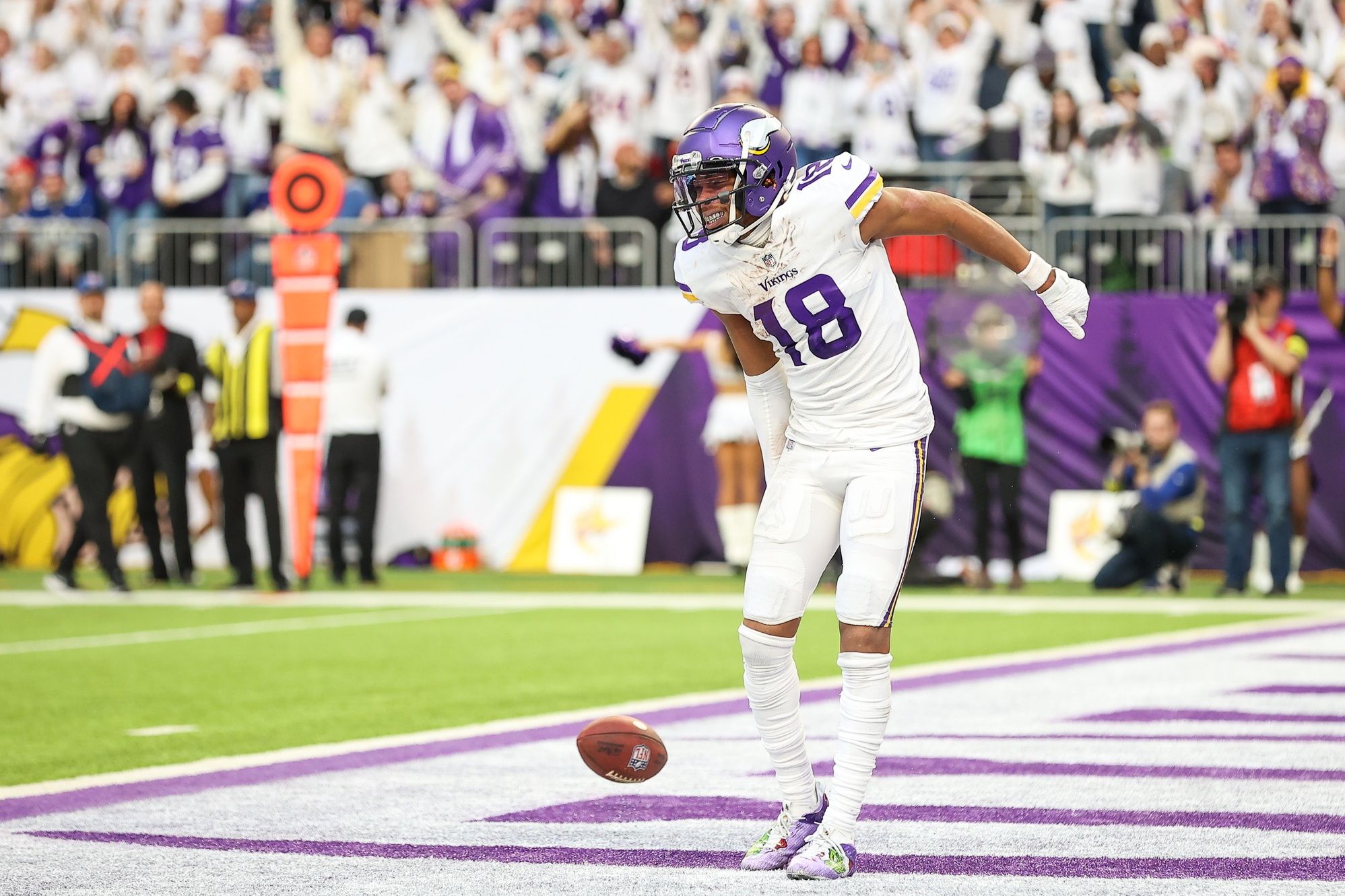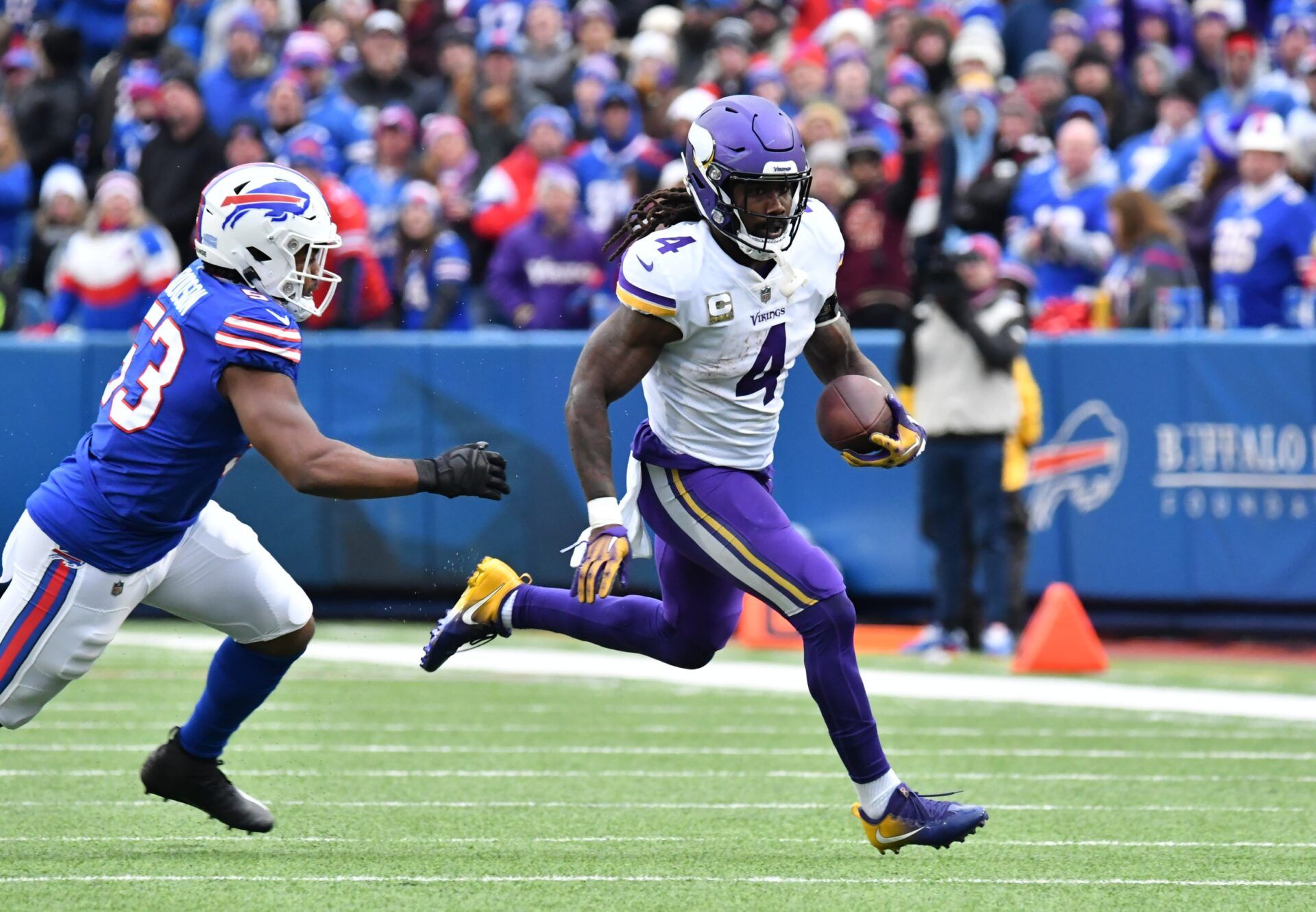Pat McAfee riled up a bit of a controversy when he argued that Minnesota Vikings running back Dalvin Cook helped drive some of the success Justin Jefferson saw last year on his way to a 1,809-yard season.
On the Pat McAfee Show, the former Indianapolis Colts punter said, “Dalvin Cook was their offense — the reason why I think Justin Jefferson has all of the things is because Dalvin Cook is in the backfield.”
McAfee probably did not intend to imply that Cook is solely responsible for Jefferson’s incredible production last year, but the wording of his take drew some ire. Nevertheless, it is an important question for the Vikings: Did Cook help Jefferson produce his remarkable numbers?
Running Backs Do Not Generally Help Receivers
The claim doesn’t seem to make much sense when considering the Vikings’ actions. The Vikings made their thoughts on this clear when they released Cook, but it also happens to be the case that Jefferson is the best receiver in football.
On the surface, it’s easy to understand why a good running back would at least help — teams concerned about a potent rushing attack might move defenders into the box and keep them away from the types of brackets we associate with double-teams. Instead of hanging a linebacker or nickel defender higher up in an underneath zone, teams scared of Cook would scoot that linebacker up and inside to better cover gaps.
On top of that, one can imagine that the coverage concepts change to bring more players into the box. That would mean keeping a safety up top and bringing one within eight yards of the line of scrimmage in order to cover up all the gaps in the running game.
That makes it harder to run two-high coverages, as a defender would have much further to backpedal in order to hit their zone landmarks. So, this would remove a safety from Jefferson’s coverage assignment and put him into one-on-one situations.
Indeed, that argument is how McAfee and his co-hosts, including former Cincinnati Bengals cornerback Adam Jones, clarified their statement — that Cook induces loaded boxes and produces more one-on-one matchups.
Across the NFL and throughout recent league history, there has been little evidence that this plays out in a meaningful way.
There has been little to no evidence that rushing success correlates to changes in coverages from the opposing defense when accounting for the number of blockers the offense puts into the box, that rushing success doesn’t drive success in the play-action passing game, and that individual running backs have a difficult time affecting play outcomes anyway.
In short, the running game might be important, but it’s not as important as people like to think. And even if the running game were important, the running back himself is less important to its success than the blockers he has in front of him and the defense he’s going up against.
Dalvin Cook Specifically Did Not Help Justin Jefferson
Even if it’s not true in the aggregate, is it possible that it’s true in the case of Jefferson and Cook? Probably not.
Cook himself has been a poor rusher over the past two years. He has performed as one of the worst backs in the NFL in rush yards over expectation calculated using two independent methods, has dropped off in his ability to generate rush yards after contact, and produced poor raw numbers on a generally average run-blocking unit.
The Vikings ranked 27th in total rushing yards, 26th in rush yards per attempt, 29th in rushing expected points per carry, and 25th in rush success rate. There’s not a number, advanced or otherwise, that supports this position.
But it could be the case that Cook’s reputation helped. After all, it certainly seemed like teams were keyed in on Adrian Peterson well after he had turned into a more average back in 2015 and 2016. If that’s true, we should see that in the types of responses defenses had for Jefferson.
Justin Jefferson Drove Defensive Looks More Than Dalvin Cook

We don’t see Cook’s reputation play out like that, however. Cook faced an eight-person box on 18.9% of his carries, which was less than the NFL average and ranked 19th of the 44 backs that Next Gen Stats has data for.
Matt Harmon at Reception Perception manually logged a large sample of routes for 44 different NFL receivers for the 2022 season, including all of the most productive receivers in the NFL.
Of those 44 receivers, Jefferson faced double-teams more often than anyone else, at a rate of 21.1% of his man coverage snaps in Harmon’s data.
This matches the data from Pro Football Focus, which indicate that Jefferson saw more double-teams in man coverage than any other receiver with at least 350 routes and more double-teams of any type in any coverage than any other receiver. Only Cooper Kupp, who ran 322 routes, saw more in man coverage.
That meant that when defenses were in man coverage, Jefferson was double-teamed on 25.4% of those plays, according to PFF.
The gap is large, too — Jefferson was double-teamed on 227 passing snaps when including bracketed coverage. The next-most doubled receiver was Davante Adams, who was doubled on 188 routes. Not only that, no receiver in the top 20 received a higher grade when double-teamed than Jefferson, indicating that he knows how to produce in those situations.
Jefferson has had six career games without Cook. In those six games, he produced 53 receptions for 839 yards with four touchdowns on 69 targets. Over a 17-game season, that would be worth 150 receptions for 2,377 yards with 11 touchdowns on 196 targets.
While Jefferson was more efficient when Cook was on the field in 2022 — he ran 512 routes at 2.83 yards per route run with Cook vs. 178 routes at 2.03 yards per route run without him — much of that benefit came on play action, where Jefferson ran 2.88 yards per route run.
Play action produces benefits regardless of the running back on the field, and Jefferson has shown an ability to take advantage of it throughout his career, even in games without Cook.
Even more damning is the fact that coverage hasn’t changed with Cook on the field instead of Alexander Mattison. The Vikings saw a version of two-high safety looks on 361 of their passing snaps, the most in the NFL.
The frequency of snaps with the middle of the field open (often called MOFO, as opposed to MOFC, with the middle of the field closed) didn’t change much from Cook to Mattison — 48.6% of Cook’s snaps were MOFO compared to 53.4% for Mattison.
All in all, it seems like Jefferson produced because he’s elite and that Cook was more likely a liability to Jefferson’s prospects than a help. Teams did not indicate that they had any respect for Cook and were willing to empty the box and double-team Jefferson in order to defend him.

